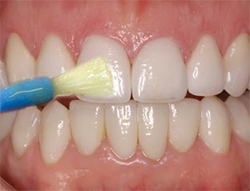Fluoride Treatment
 While
much has been written about the pros and cons of fluoride in
municipal water supplies, and about the benefits and risks of
fluoride toothpaste and topical dental fluoride treatments, it
is undeniable that fluoride helps to prevent tooth decay, and is
an effective way to protect tooth enamel from the deleterious
effects of excess acid in the mouth. While
much has been written about the pros and cons of fluoride in
municipal water supplies, and about the benefits and risks of
fluoride toothpaste and topical dental fluoride treatments, it
is undeniable that fluoride helps to prevent tooth decay, and is
an effective way to protect tooth enamel from the deleterious
effects of excess acid in the mouth.
That being said, there is
much less agreement on the amount of fluoride that is
beneficial, although it is generally acknowledged today that
fluoride is as helpful for adult teeth as it is for a childís
teeth. One way to ensure that your teeth are adequately
protected is to speak to your dentist about your medical and
dental history, your eating and dental hygiene habits, and your
history of dental caries and gum problems. Your dentist will
help assess the need for periodic fluoride treatments and will
explain the reasons for beginning such treatments if you
havenít routinely had topical fluoride applied.
What Is Fluoride?
A natural mineral,
fluoride is present in some foods and beverages, notably black
tea, seedless raisins, grape juice and wine, blue crab and
shrimp, and coffee. Because added fluoride is so common in
water, foods and beverages that are prepared with tap water will
also normally contain fluoride, but the amounts are minimal and
generally inadequate to provide any measurable dental benefit.
The best way to boost the
level of protection and to assure that your tooth enamel reaps
the benefits of fluoride is to add other products that contain
the mineral to your daily dental routine. Brushing with fluoride
toothpaste, for instance, can help to slow the buildup of acid
that leads to formation of destructive bacteria. There are also
mouth rinses that contain fluoride, as well as supplements in
both liquid and tablet form. Topical treatments applied by your
dentist are relatively long lasting, and are some of the best
ways to assure that your teeth remain as healthy as possible.
Over-the-counter products
contain low doses of the mineral, whereas your dentist may
recommend a higher dose product that is available only by
prescription. There are few risks associated with fluoride, even
at higher levels. Sometimes a white spotting on tooth enamel is
noticed in children, but it is usually minor.
Best Reasons for Fluoride
Use
Fluoride levels in the
body fluctuate; every day, your body absorbs some and loses
some. Because the level of fluoride is not constant, it must be
routinely replaced in order to continue to help tooth enamel
resist the bacteria that cause decay.
Research confirms that
fluoride strengthens existing enamel and can sometimes even help
repair damaged enamel. In young children, fluoride is also
beneficial for developing teeth. But it is just as vital for the
adult mouth, perhaps even more important in some ways.
There are a number of
adult conditions that increase the risk of decay:
- Dry Mouth, caused by
chronic illness or medications
- Gum Diseases, including
gum recession that expose more of the tooth structure
- Frequent Cavities, and
a history of dental problems
- Crowns, Bridges or
Braces
- Pitted or Grooved Teeth
- Teens and adults who
are habitual snackers, and those who consume large
quantities of carbonated beverages or sweet desserts are
also more prone to dental problems, whether they stem from
inadequate hygiene or excess sugar.
Some professionals caution
against fluoride toothpaste for toddlers and young children
because they often swallow the paste, and this can result in
higher concentrations of fluoride in their systems. However,
many believe that the benefits outweigh any risks. Fluoride,
combined with proper brushing and flossing, a healthy diet and
regular dental checkups, should assure a bright dental future.
Ongoing Fluoride
Treatments
Several types of topical
fluoride procedures are available: The most common are applied
as a gel, foam or varnish by your dentist during a scheduled
visit. Application is a quick, non-invasive office procedure
that requires no special preparation. Often, there is no waiting
period required afterwards before eating or drinking normally.
Although prices vary, most fluoride treatments are reasonable,
and many dentists recommend a treatment in conjunction with a
normal checkup every six months.
Dental insurance may
typically pay for the cost of such semi-annual treatments up to
the age of 14 or 18, but coverage varies widely. While some
plans disallow treatment coverage for adults, other companies
may treat the cost as a preventive measure, preferring to
reimburse patient for part of all of the fee rather than paying
for future fillings or dental repairs. If you have dental
coverage, itís always wise to check in advance about your
particular companyís policies.
If you would like to
schedule an appointment, please call us at 248-644-3414
|

